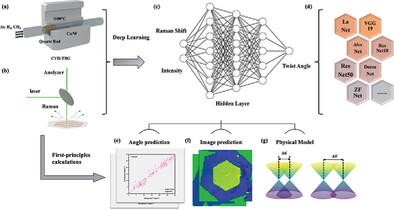Deep-Learning-Enabled Fast Raman Identification of the Twist Angle of Bi-Layer Graphene
IF 13
2区 材料科学
Q1 CHEMISTRY, MULTIDISCIPLINARY
引用次数: 0
Abstract
Twisted bilayer graphene (TBG) has drawn considerable attention due to its angle-dependent electrical, optical, and mechanical properties, yet preparing and identifying samples at specific angles on a large scale remains challenging and labor-intensive. Here, a data-driven strategy that leverages Raman spectroscopy is proposed in combination with deep learning to rapidly and non-destructively decode and predict the twist angle of TBG across the full angular range. By processing high-dimensional Raman data, the deep learning model extracts hidden information to achieve precise twist angle identification. This approach is further extended to a 2D plane, enabling accurate orientational mapping within individual samples. Through interpretability analysis, the model is validated in conjunction with first-principles theoretical calculations, ensuring robust and explainable results. This data-driven methodology not only facilitates efficient TBG characterization but also introduces a broadly applicable framework for studying other angle-dependent 2D materials, thereby advancing the field of material spectroscopy and analysis.

求助全文
约1分钟内获得全文
求助全文
来源期刊

Small
工程技术-材料科学:综合
CiteScore
17.70
自引率
3.80%
发文量
1830
审稿时长
2.1 months
期刊介绍:
Small serves as an exceptional platform for both experimental and theoretical studies in fundamental and applied interdisciplinary research at the nano- and microscale. The journal offers a compelling mix of peer-reviewed Research Articles, Reviews, Perspectives, and Comments.
With a remarkable 2022 Journal Impact Factor of 13.3 (Journal Citation Reports from Clarivate Analytics, 2023), Small remains among the top multidisciplinary journals, covering a wide range of topics at the interface of materials science, chemistry, physics, engineering, medicine, and biology.
Small's readership includes biochemists, biologists, biomedical scientists, chemists, engineers, information technologists, materials scientists, physicists, and theoreticians alike.
 求助内容:
求助内容: 应助结果提醒方式:
应助结果提醒方式:


